Digital done differently.
Modeling done flawlessly.
Casio’s phase distortion synthesis was a relative of FM but simpler to use, achieving patches that sounded both ‘digital’ and ‘analog’ with equal ease.
It became a sonic staple for artists including Eurythmics, Salt-N-Pepa, and Vince Clarke (Depeche Mode, Yaz, Erasure), who famously stacked up eight CZ-101 synths and a sequencer. CZ V gives you more of what the CZ was loved for in every way – and more.
Expertly Engineered
Our DSP crew reverse-engineered the core code of the CZ, then added features to make phase distortion even more compelling today.
Shockingly Flexible
The CZ series is used on all kinds of songs because it produced so many sounds so well. Let CZ V do the same for you.
CZ = EZ
Wringing a ton of sonic range out of just a handful of parameters, CZ V is one of the quickest paths from a sound in your head to sound in your speakers.
Turbocharged
We amped up the CZ with up to 32 voices of polyphony, four FX slots, eight envelopes, and everything but a flux capacitor.
More than just
a phase
The CZ-101 defined a whole new way of creating the sounds keyboardists and producers wanted. This put Casio® on the map as a maker of serious professional synthesizers. CZ V puts phase distortion back on the map with the ultimate version of this groundbreaking synthesis technology.
In the early ’80s, Casio wasn’t about to sit still while the DX7 took over the world. Fortunately, they had a platform to build on — a high-end synth workstation called Cosmo. It’s the direct ancestor of the CZ-101, whose mini keys and $499 price tag put real synthesis in the hands of a new generation of musicians.
Discover the history of CZ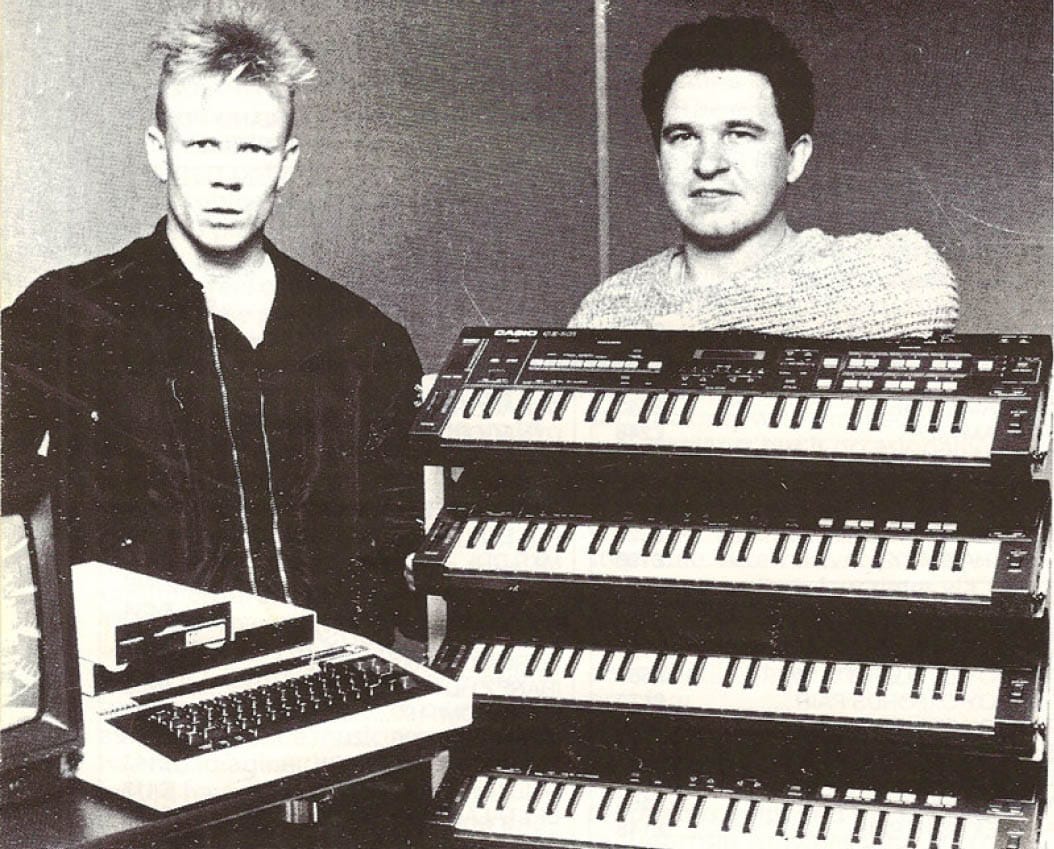
A different kind of
of distortion
Phase distortion, like FM, involves one oscillator modulating another.
Phase distortion's uniqueness comes into play by altering the time domain of the carrier wave, yielding a different oscillator wave shape entirely. By changing the linearity of how a simple waveform plays, like speeding up the start of the cycle, it’s no longer a simple waveform. That’s the concept at the heart of phase distortion synthesis and CZ V’s sound.
DCO > DCW > DCA
Each DCO in CZ V lets you select from the 8 original waveforms or draw your own. Some serial combinations of two different waveforms are provided for, resulting in many more possibilities. Each DCO is followed by a corresponding digitally controlled waveshaper (DCW) section, including key follow and an 8-stage envelope generator. This animates the amount of waveshaping from the modulator over time. There’s also an eight-stage envelope for DCO frequency, allowing for pitch-change effects far beyond vibrato, trills and lasers. A digitally controlled amplifier (DCA) with its own eight-stage envelope rounds out a DCO>DCW>DCA signal chain roughly equivalent to that of analog VCO>VCF>VCA.
Between the lines
Like the original, the CZ V has two complete DCO>DCW>DCA signal lines that you can use individually or in parallel. Duplicate settings in each line allows for a fatter sound given the ability to transpose and/or detune them, while separate settings provide for much more complex timbres. You might, for example, shape a hyper-percussive sound in one line and craft a pad in the other to combine into a compound timbre. Other goodies faithful to the original include a dedicated vibrato section, polyphonic portamento, ring modulation and noise modulation.
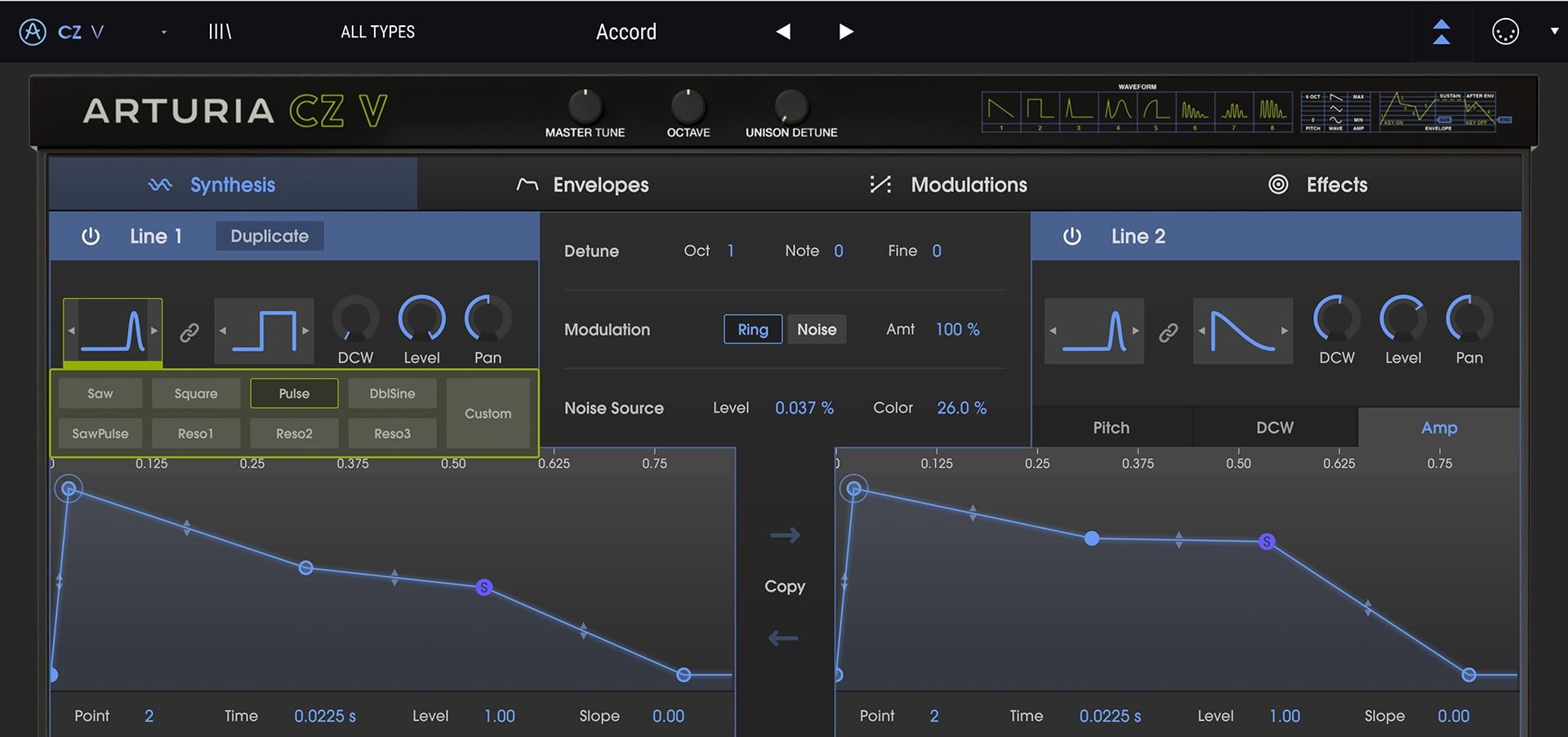
Simple Synthesis
Ultimately, the beauty of PD compared to the better-known FM is that there are only four primary things that really control the timbre of each CZ line: the DCO’s modulating waveform and the three envelopes. Both PD and FM have made significant and instantly recognizable contributions to music, but the simpler concept of PD can ironically get a lot closer to analog bass, brass, strings and more with a lot less fiddling.
Our DSP team reverse-engineered the code inside the CZ-series and even modeled the DAC outputs, delivering the perfect combination of authentic PD behavior and that crunchy, almost-lo-fi sound of the ‘80s, right in your DAW.
A CZ for
Today
The CZ-101 had an instant and intuitive interface, especially for an early digital synth - yet CZ V is quicker and more performance-oriented in every way.
Everything you need for breathtaking tracks and gig-ready sounds is arranged for maximum connection between thoughts, hands, and music.
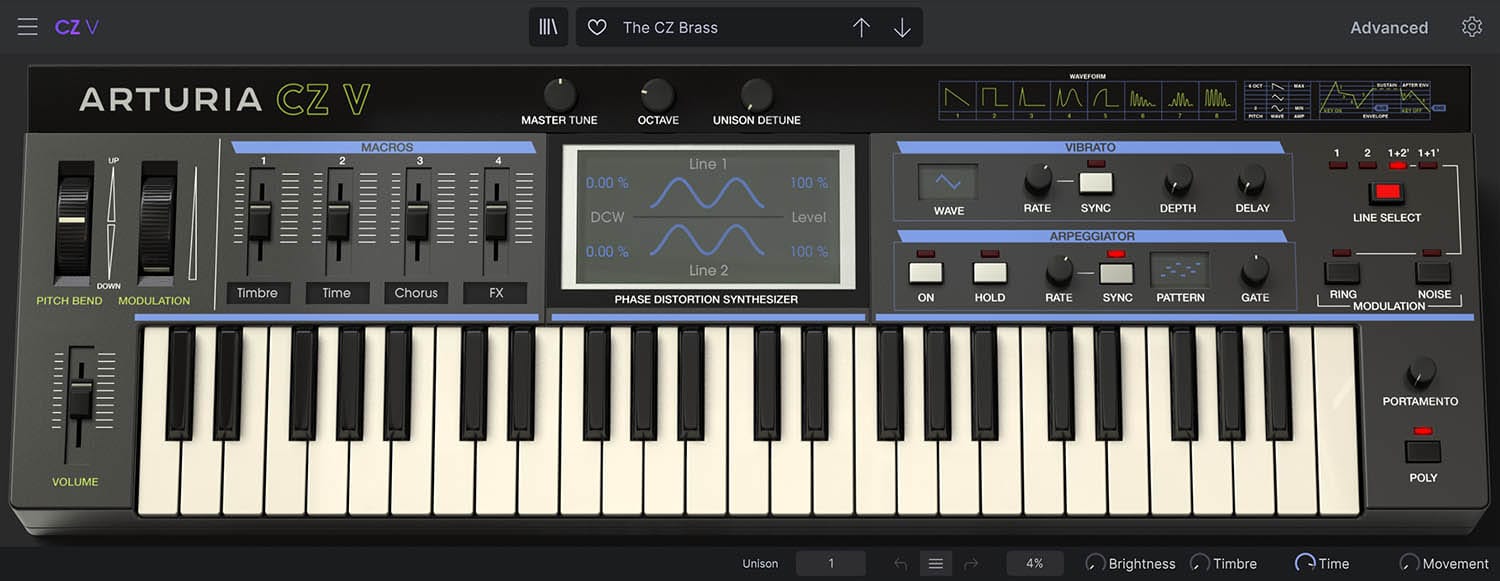
_1
_2
_3
_4
_5
_6
01. Eyes Meet Ears
See exactly what’s happening to your sound as you play and the waveforms morph, right in the central display area.
02. Drop the Bass, Tweak the FX
Four sliders can each control multiple parameters at once for performance gestures from subtle to drastic.
03. Dedicated Vibrato
We’ve upgraded the CZ’s stand-alone vibrato section with more waveforms, tempo sync, and adjustable delay.
04. Guilty Pleasure Generator
What would an ’80s synth be without a classic arpeggiator? Ours features six patterns (including as-played and random) and up to a 4-octave range.
05. Line Up
Choose to hear Line 1, Line 2, both, or Line 1 plus a copy of itself. Then, ring- or noise-modulate them here.
06. Poly or Mono
Toggle into mono mode for thick unison leads on solos, then back to poly for playing chords, with one button.
A CZ for
Tomorrow
Massive synthesis power lurks just beneath the surface in CZ V’s Advanced Panel. We’ve made all of it fun and easy to use.
If this much capability had been packed into hardware, phase distortion might have become the dominant synthesis method in music. Our Advanced interface makes it more intuitive than ever to see just how far PD can go.
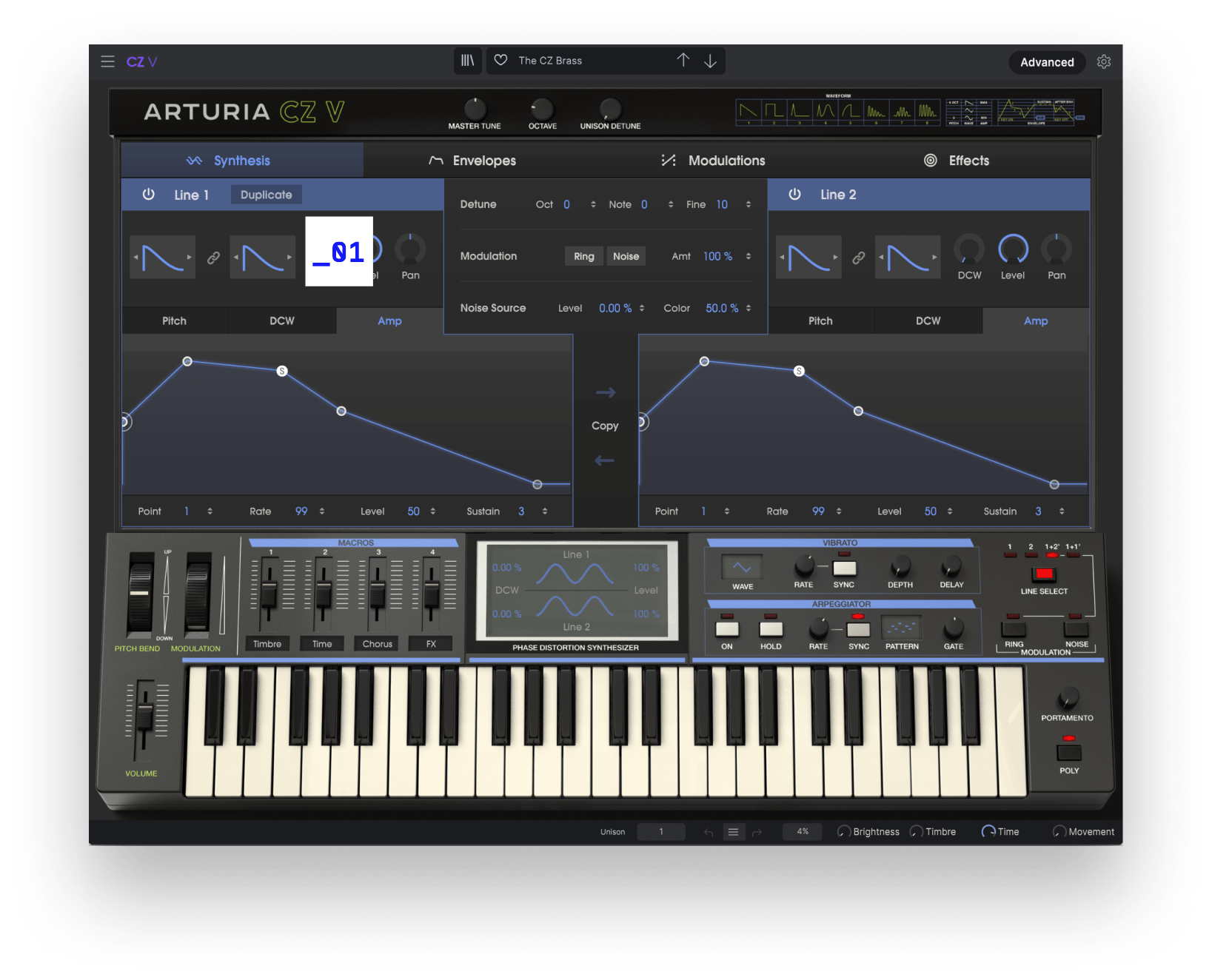
With different target waveforms for the first and second cycle in each Line, creating ear-grabbing harmonic motion is a snap!
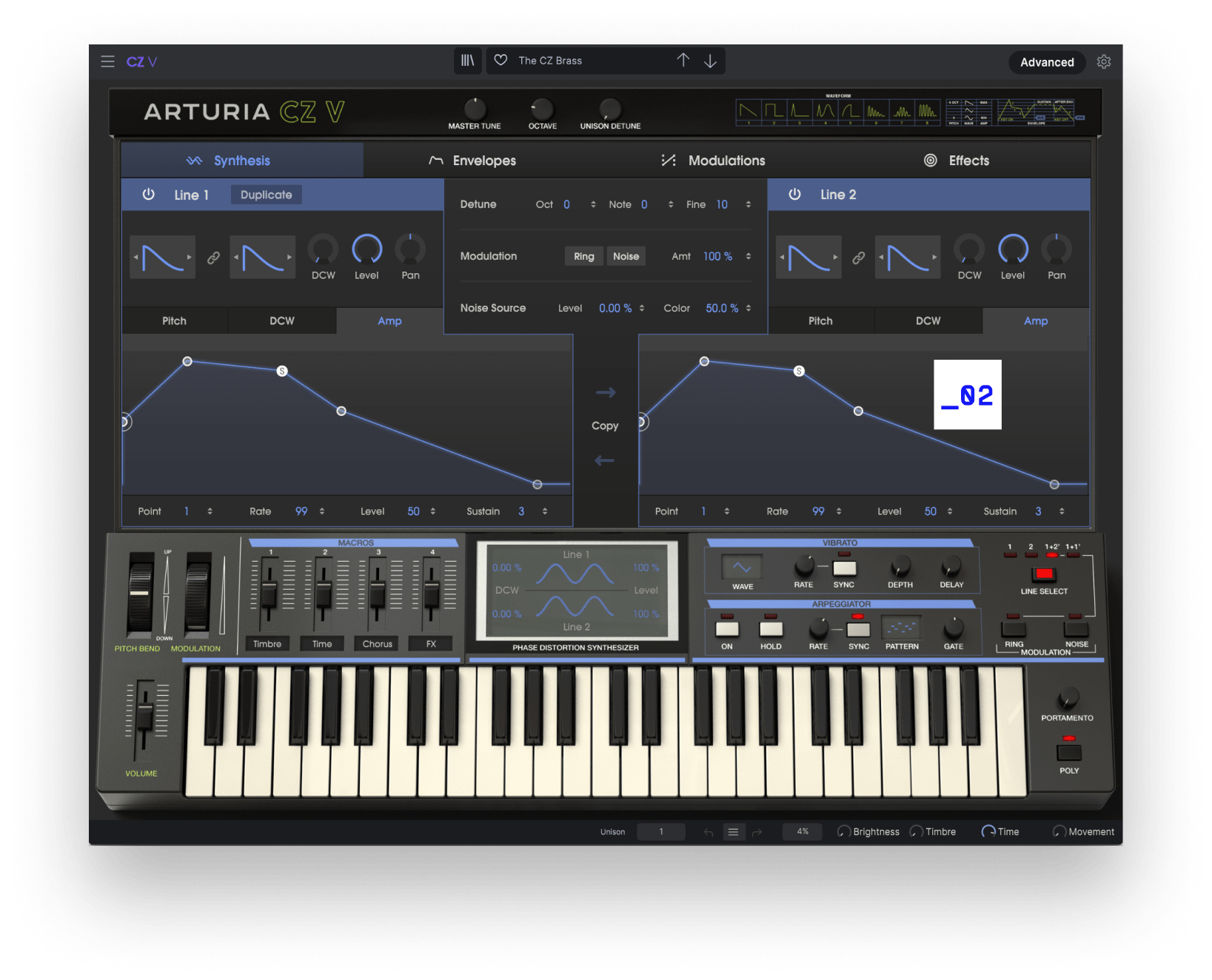
CZ V duplicates the hardware’s eight waveform choices, but if you want something different, just draw and save your own to produce any sound imaginable.
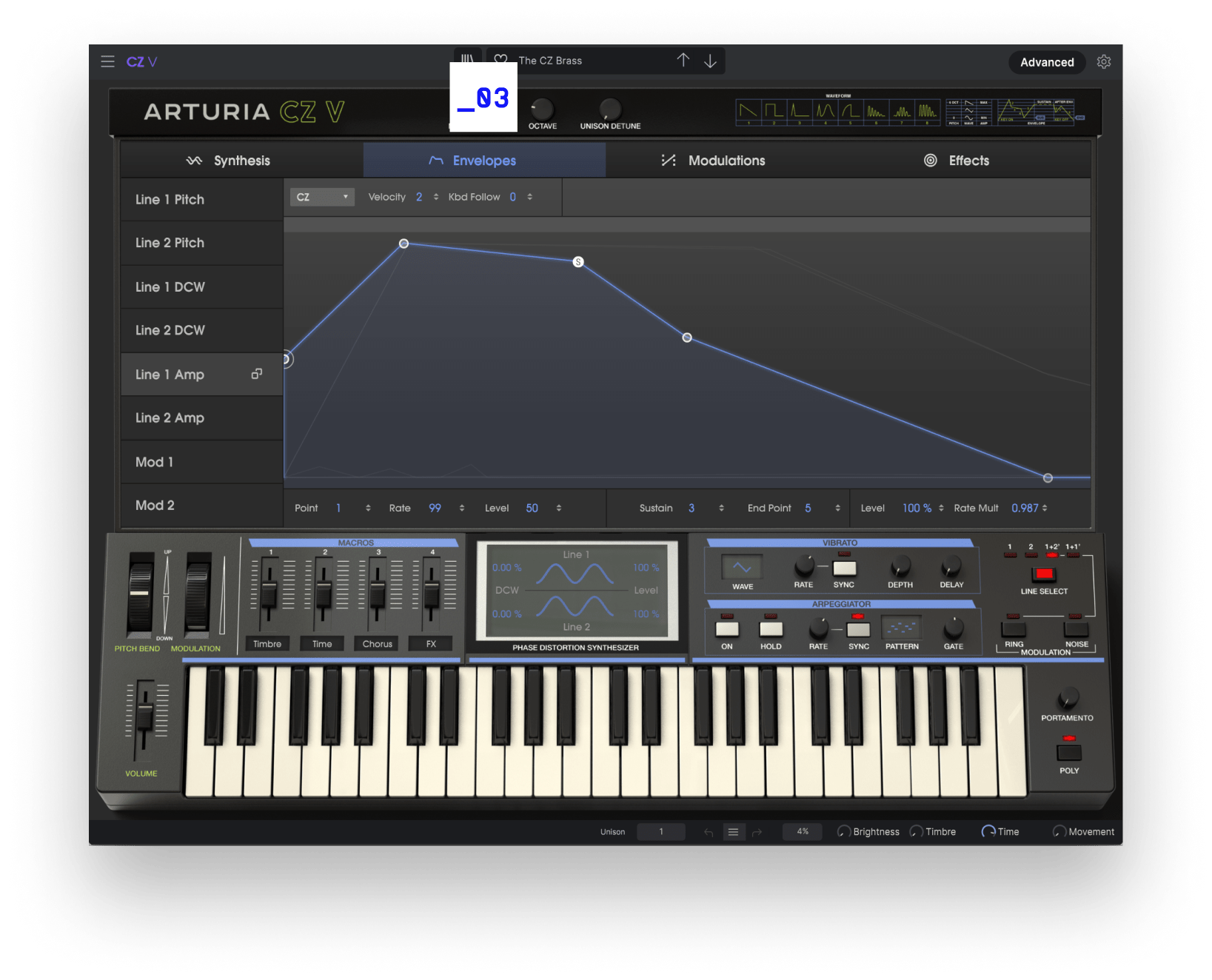
Separate envelopes for pitch, PD amount (DCW), amp, and modulation for each Line power sounds that move, evolve, and interweave.
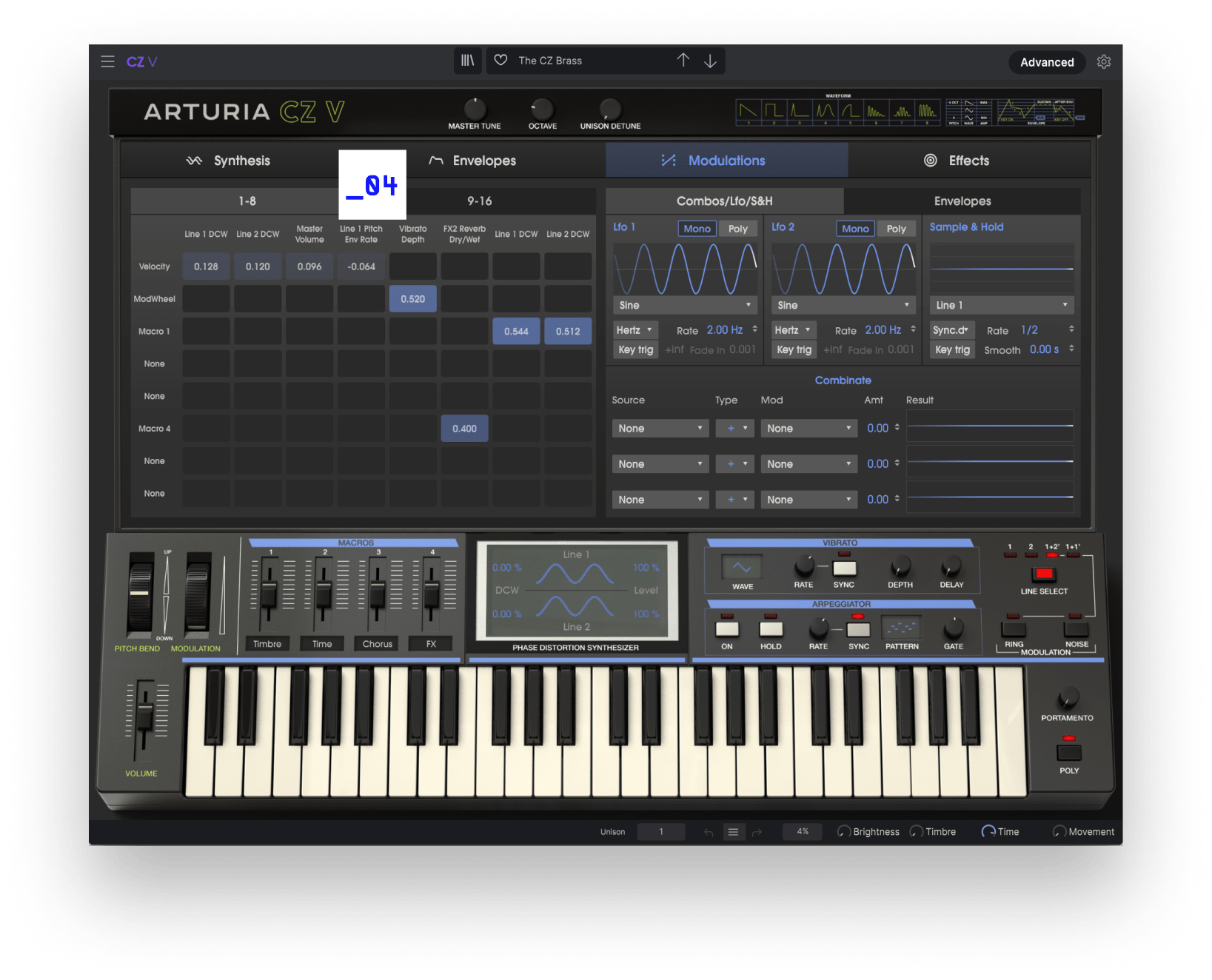
Assign multiple sources including the Macro sliders to a staggering number of destinations here — no hardware CZ had this many modulation options.
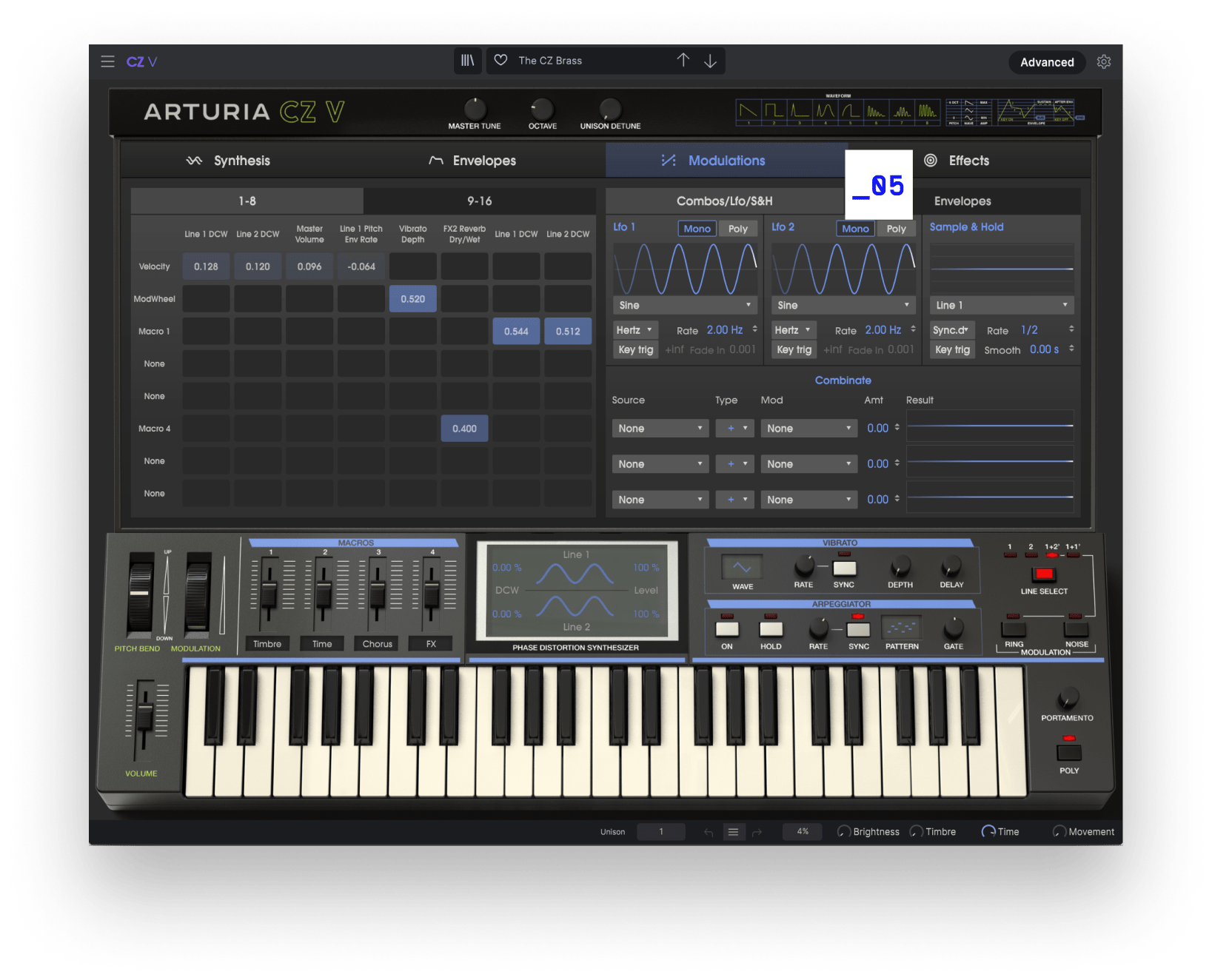
We added assignable LFOs and envelopes. Then, blend any two modulation sources into something completely different using the Combinator slots.

Run Lines 1 and 2 in series or parallel through studio-quality effects. Missing that analog-style synth filter? It’s here!
Hear it
in action
Could someone do an entire album using just CZ V sounds?
Listen to these audio demos from prominent artists and sound designers and judge for yourself. (Hint: We think so!)
Chunky House
Cinematic
DrumBass Desires
Lost Land
Mouvances
Nostalgia
SlowCore
Trance
Tropical Serenade
Presets
CZ V is surprising because it can sound like an analog synth.
It can sound like a DX. It can sound like a PPG Wave. It can generate evocative pads and choirs. And much more. Check out some select highlights from its built-in library of 500+ presets.
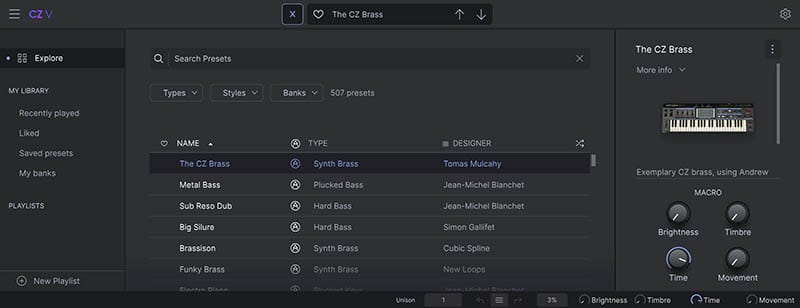
Artistscorner
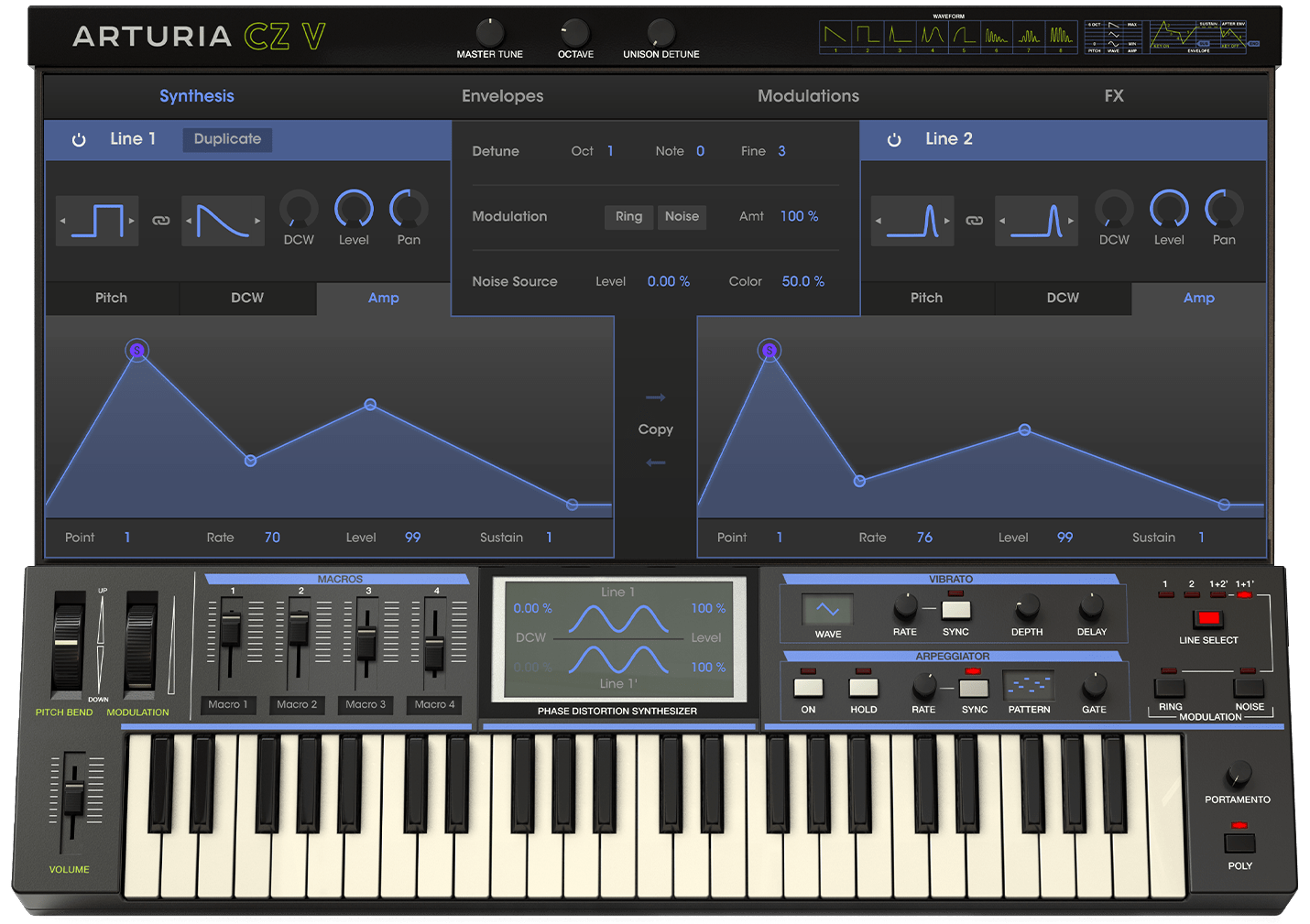
Included in
V collection
Legendary Keyboards Reinvented
This instrument is also part of the V Collection -your complete dream line-up of the legendary synths, organs, pianos and more that made keyboard history. They’re modeled with the most advanced technologies for authentic realism, and enhanced with new creative options. Whether you use it as DAW plugins in the studio or standalone at gigs, V Collection puts the greatest keys of all time at your fingertips for instant inspiration.
Learn More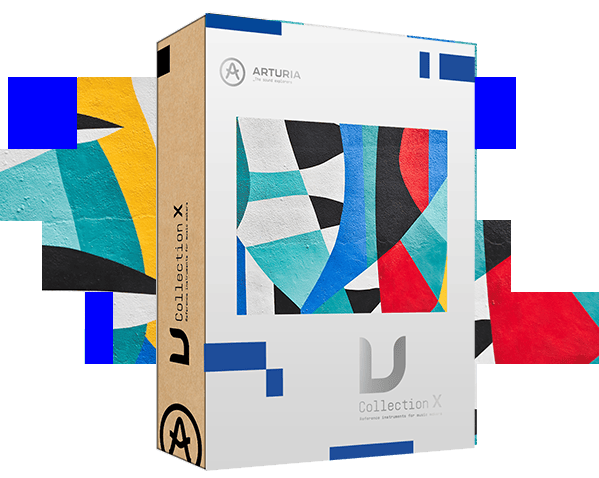
Las características
necesitas

Los tutoriales integrados en la app te guían en todos los aspectos del instrumento, desde parámetros individuales hasta consejos de nuestros diseñadores de sonido, para que te puedas centrar en la parte creativa. Cuesta creer que resulte tan fácil, pero así es.

Arturia Software Center te permite descargar, organizar y actualizar todo tu software de Arturia desde el mismo sitio, además de gestionar tus licencias en varios dispositivos. Así de sencillo.

Nuestros instrumentos virtuales y plugins están diseñados para integrarse fácilmente en tu estudio. Sea cual sea tu estilo, podrás explorar los sonidos y disfrutar de total compatibilidad con los principales DAW, tanto en Windows como en MacOS.

Encuentra al instante el sonido que tienes en mente gracias a la exploración inteligente y optimizada de presets. Busca con palabras clave, explora por tipo de instrumento, estilo musical, etc… Hasta puedes guardar tus presets favoritos para acceder rápidamente a ellos más adelante.

Tanto si buscas las inmersión visual completa de nuestras emulaciones de instrumentos clásicos como si prefieres ocupar el menor espacio en pantalla, las interfaces de todos tus instrumentos virtuales Arturia se pueden redimensionar a la escala que mejor te vaya.

Los instrumentos vienen preasignados de forma natural para la gama de controladores Arturia KeyLab, aunque también funcionarán estupendamente con otros controladores MIDI. Macros para alterar los sonidos al instante, integración sencilla con tu DAW y funcionamiento autónomo.
Gallery
Main Features
Two synthesis lines and independent noise source
All CZ-101/CZ-1000 original parameters
8 original waveform and custom waveform editor
Original CZ SysEx import
CZ, DADSR and Multi-Segments envelopes (syncable and loopable) to control pitch, DCW and amplitude
2 Modulation envelopes
4 assignable macros
Advanced modulation matrix
A Sample and Hold module, 2 LFOs with 6 waveforms, 3 sources combinators and an Arpeggiator
4 FXs slots that can be routed in serie or per synthesis line
A synthesis line state viewer for real-time feedback
Emulation of the original CZ DAC
32 voices of polyphony
Up to 8 voices of unison with unison detune
Over 400 factory presets
Platform specifications
Windows
- Win 10+ (64bit)
- 4 GB RAM
- Procesador de 4 núcleos a 3,4 GHz (4,0 GHz en modo Turbo)
- 3 GB de espacio libre en disco
- Gráfica compatible con OpenGL 2.0
- No funciona con procesadores ARM en Windows
Configuración mínima
- Funciona de forma autónoma y como VST, AAX, Audio Unit y NKS (únicamente en DAW de 64-bits).




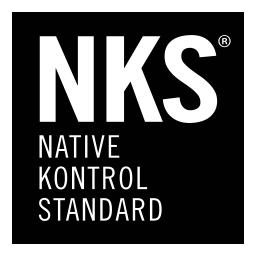
Apple
- Mac OS 11+
- 4 GB RAM
- Procesador de 4 núcleos, 3,4 GHz (4,0 GHz en modo Turbo) o procesador M1
- 3 GB de espacio libre en disco
- Gráfica compatible con OpenGL 2.0
Funciona con ASC
- Una solución elegante y sencilla para instalar, activar y actualizar tus instrumentos virtuales de Arturia.
Todos los nombres de fabricantes y productos mencionados en esta página son marcas comerciales de sus respectivos titulares, que de ninguna manera están asociados o afiliados con Arturia. Las marcas comerciales de otros fabricantes se usan únicamente para identificar los productos de aquellos fabricantes cuyas características y sonido se estudiaron durante el desarrollo. Todos los nombres de equipos, inventores y fabricantes se han incluido únicamente con fines ilustrativos y educativos, y no sugieren ninguna afiliación ni respaldo por parte de ningún inventor o fabricante de equipos.




